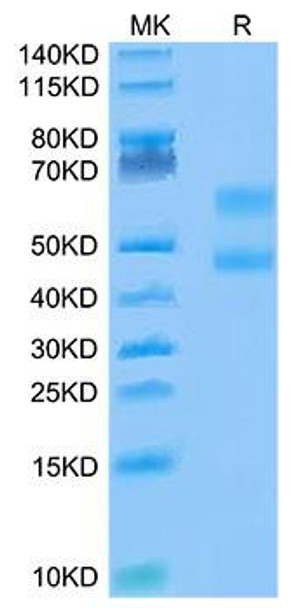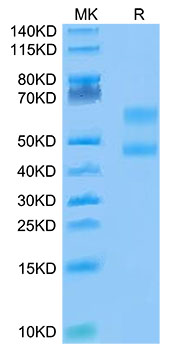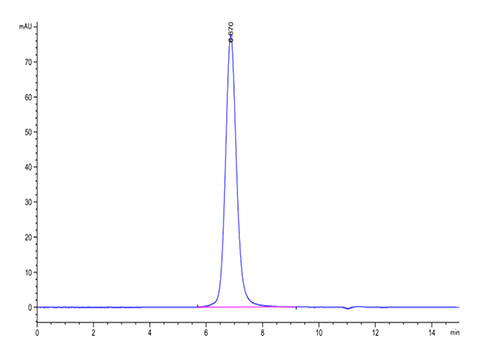Description
Biotinylated Recombinant Cynomolgus CD3E&CD3D Protein (Primary Amine Labeling)
The Biotinylated Recombinant Cynomolgus CD3E&CD3D Protein (Primary Amine Labeling) is a specially modified recombinant protein featuring biotin conjugation for enhanced detection and purification capabilities. This biotinylated variant is particularly valuable in immunoassay development, protein interaction studies, flow cytometry applications, and biosensor technologies, offering researchers improved sensitivity and specificity in experimental workflows requiring streptavidin-biotin binding systems.
This product (SKU: RPCB0096) is produced using advanced expression systems and features a C-hFc tag for convenient detection and purification. The protein exhibits a calculated molecular weight of 36.9 kDa (CD3E), 35.4 kDa (CD3D) with an observed molecular weight of 58-62 kDa(CD3E), 44-46 kDa (CD3D) under denaturing conditions, achieving ≥ 95 % as determined by Tris-Bis PAGE;≥ 95 % as determined by HPLC., ensuring exceptional quality and consistency for research applications.
Key Features
| High Purity by Affinity Chromatography | |
| Mammalian & Bacterial Expression Systems | |
| High lot-to-lot consistency via strict QC |
| Product Name: | Biotinylated Recombinant Cynomolgus CD3E&CD3D Protein (Primary Amine Labeling) |
| SKU: | RPCB0096 |
| Size: | 100 μg |
| Reactivity: | Cynomolgus |
| Synonyms: | CD3, CD3e, CD3E, CD3d, T3D, CD3D, CD3E&CD3D, CD3 delta&CD3 epsilon |
| Tag: | C-hFc |
| Calculated MW: | 36.9 kDa (CD3E), 35.4 kDa (CD3D) |
| Observed MW: | 58-62 kDa(CD3E), 44-46 kDa (CD3D) |
| Protein Description: | High quality, high purity and low endotoxin recombinant Biotinylated Recombinant Cynomolgus CD3E&CD3D Protein (Primary Amine Labeling) (RPCB0096), tested reactivity in HEK293 cells and has been validated in SDS-PAGE.100% guaranteed. |
| Endotoxin: | < 1 EU/μg of the protein by LAL method. |
| Purity: | ≥ 95 % as determined by Tris-Bis PAGE;≥ 95 % as determined by HPLC. |
| Formulation: | Lyophilized from a 0.22 μm filtered solution of PBS, pH 7.4. |
| Reconstitution: | Centrifuge the tube before opening. Reconstitute to a concentration of 0.1-0.5 mg/mL in sterile distilled water. Avoid vortex or vigorously pipetting the protein. For long term storage, it is recommended to add a carrier protein or stablizer (e.g. 0.1% BSA, 5% HSA, 10% FBS or 5% Trehalose), and aliquot the reconstituted protein solution to minimize free-thaw cycles. |
| Storage: | Store at -20℃. Store the lyophilized protein at -20℃ to -80℃ up to 1 year from the date of receipt. After reconstitution, the protein solution is stable at -20℃ for 3 months, at 2-8℃ for up to 1 week. |
T-cell surface glycoprotein CD3 epsilon & CD3 delta chain, also known as CD3E & CD3D, are single-pass type I membrane proteins.When antigen presenting cells (APCs) activate T-cell receptor (TCR), TCR-mediated signals are transmitted across the cell membrane by the CD3 chains CD3D, CD3E, CD3G and CD3Z. All CD3 chains contain immunoreceptor tyrosine-based activation motifs (ITAMs) in their cytoplasmic domain.








